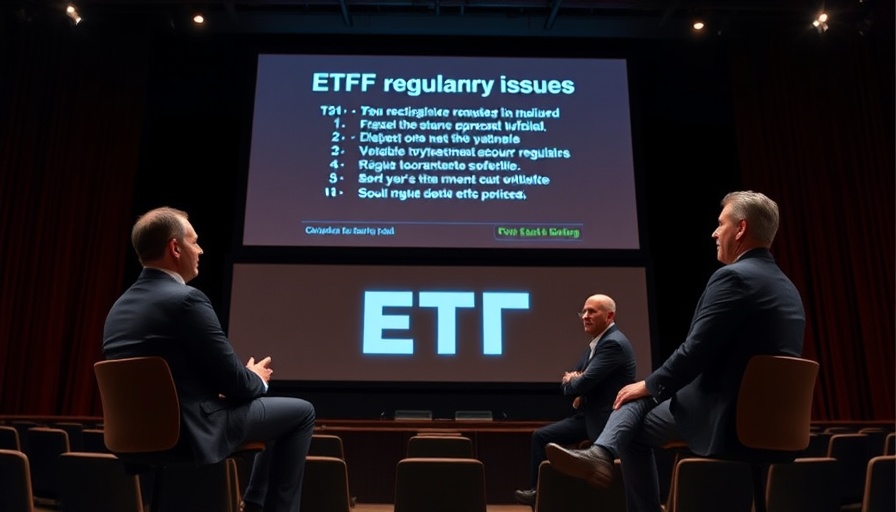
The Regulatory Landscape for ETFs: What’s Changing?
The recent discourse surrounding the regulatory environment for ETFs signals a pivotal shift that could redefine the investment landscape, especially for asset managers long beleaguered by stringent regulations. As emerging insights from industry panels suggest, the anticipated approach from a new SEC under the second Trump administration hints at a strategic pivot towards encouraging innovation and efficiency, particularly regarding dual-class structures and crypto ETFs.
Addressing Past Tensions: A New SEC Narrative
Joe Mannon, chair of the private fund formation group with Vedder Price, summarized the industry sentiment succinctly: “A cloud has lifted.” This expression encapsulates a decade plagued by not just regulatory scrutiny, but what many viewed as "regulation by enforcement." Historically, the SEC's focus often fixated on penalizing technicalities rather than addressing genuine fraudulent behaviors—a trend that left many asset managers in a bind. If recent signals from SEC Commissioner Mark Uyeda are any indication, the environment seems primed for more collaborative engagement, encouraging a proactive dialogue that hasn’t existed in years.
Understanding Dual-Class Structures: The Holy Grail for Asset Managers
At the heart of the panel’s discussions was the anticipated approval of dual-class structures. This regulatory change permits asset managers to offer ETFs and mutual fund share classes on the same financial vehicles, enhancing flexibility and potentially revolutionizing strategies for many firms. The expiration of Vanguard's dual-class patent in 2023 has ushered a wave of over 50 petitions from other asset managers eager to embrace this model. The SEC’s intention to prioritize this issue is evident, but the exact timeline remains a point of speculation, reflecting the cautious optimism that surrounds these developments.
Risk Factors in Accelerated Approvals
However, a rapid regulatory approval process brings its own challenges. Panelists expressed concerns that even if the SEC moves swiftly to approve these structures, many asset managers might not be operationally equipped to implement them. Given the historical inertia of government processes—particularly within regulatory agencies—any acceleration could blindside those unprepared to adapt quickly. The panel’s emphasis on operational readiness highlights a critical nexus between regulatory changes and real-world consequences.
Innovation on the Horizon: The Crypto and Private Market ETFs
Attention is also intensifying around crypto and private market ETFs. Industry experts recognize these areas as ripe for disruption and are keenly observing how the SEC’s new stance may either facilitate or stymie innovation. A less confrontational approach toward regulatory enforcement could pave the way for a more diverse and dynamic market, positioning the ETF sector to attract a wider spectrum of investors.
Pricing Implications and Market Strategies in a Regulatory Shift
The anticipated regulatory reforms aren’t just theoretical; they have concrete implications for pricing and market strategies. As asset managers respond to increasing competition and evolving investor preferences, they must recalibrate their pricing strategies to account for newfound operational flexibilities while remaining compliant with regulations. Understanding these nuances will be critical for small business owners and entrepreneurs who prioritize financial independence and robust growth.
What Does This Mean for Investors?
For individuals and small business owners, the implications of these regulatory changes cannot be overstated. An environment that encourages innovation could lead to more attractive investment opportunities and potentially lower costs. As competition increases, savvy investors may find themselves in a position to capitalize on innovative products that were previously stymied by regulatory constraints. Monitoring these developments closely could yield actionable insights for those looking to enhance their portfolio strategies.
Conclusion: A Call to Action for Investors
In conclusion, while optimism abounds regarding the shifting regulatory framework for ETFs, it is essential for investors to prepare effectively. Awareness and understanding of these changes are paramount for leveraging emerging opportunities in this evolving landscape. As we navigate the complexities of regulatory shifts, emphasizing operational readiness and innovative investment strategies will be vital. Don’t miss out on the transformative potential of these developments; stay informed and ready to act as the landscape evolves.
 Add Row
Add Row  Add
Add 




Write A Comment